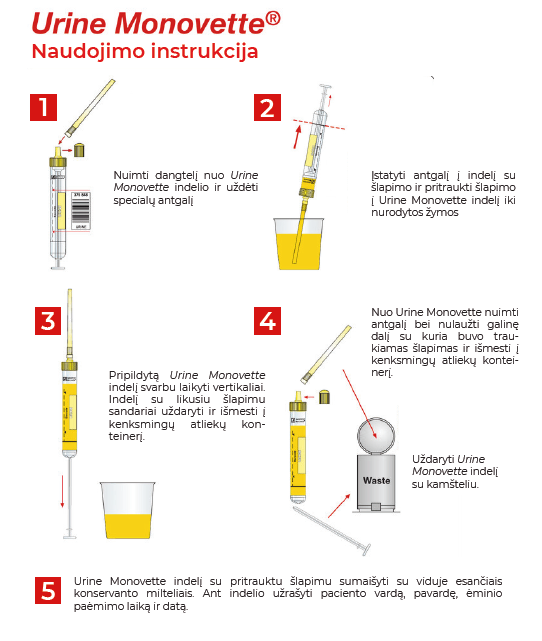How to Prepare for Urine Tests
GENERAL REQUIREMENTS FOR URINE SAMPLE COLLECTION
- It is recommended to avoid vitamin C supplements for at least 24 hours before a general urine test.
- For general and/or biochemical urine tests, the sample is collected in a special sterile urine collection container, which can be purchased at a pharmacy. The middle portion of the morning urine (about 10 ml) is collected. For urine culture, 40-50 ml of the sample is collected in a sterile container (such containers are sold packaged in a sealed bag).
- Before starting to collect urine, hands should be washed thoroughly with warm water and soap. Prepare a sterile urine container. When unscrewing the container lid and collecting urine, do not touch the inside of the container and lid surfaces with fingers.
- For infants and young children, a urine sample can be collected using urine collection bags.
Urine collection for women:
- Wash the external genitalia, including the urethral area, with running water without using any disinfectants. Dry the external genitalia with a clean disposable towel.
- After starting to urinate, allow the first portion of urine (30-50 ml) to flow into the toilet. The middle portion of the urine is collected into the container.
- While collecting urine, try not to touch the edges of the container to the genitalia. First, screw the container closed, avoiding touching the inside of the lid with hands, and only then wipe off any remaining urine.
Urine collection for men:
- The urethra is exposed, and if necessary, the foreskin is retracted.
- Wash the tip of the penis, including the area where the urethra opens, with running water. Dry the external genitalia with a clean disposable towel.
- After starting to urinate, allow the first portion of urine (30-50 ml) to flow into the toilet. The middle portion of the urine is collected into the container.
- After urination, dry the outer part of the container. Write the name, surname, date, and time of sample collection on the urine container.
- Urine samples are delivered to the laboratory at room temperature (+15...+25) °C within 2 hours of collection. If you cannot do this, the urine should be stored in a refrigerator at +4 °C for no longer than 8 hours.
- When collecting urine intended for identifying sexually transmitted pathogens, washing the external genitalia is not necessary. The first portion of morning urine is collected.
- Improper preparation, urine collection not following the recommendations, or urine delivered in a non-sterile container often distorts the test results and may require a repeat test.
24-HOUR URINE COLLECTION
- 24-hour urine is collected in 2.5-3 liter plastic containers, which can be purchased at pharmacies.
- The collected urine is stored cool, preferably at (+2...+8) °C, and protected from direct sunlight.
- Before each urination, hands and external genitalia are washed.
- Before starting 24-hour urine collection, the bladder must be emptied, i.e., urinated into the toilet. After the first urination, the time is recorded, and urine collection begins. Urine is collected for 24 hours.
- For infants and young children, a urine sample can be collected using urine collection bags.
NOTE: It is recommended to collect 24-hour urine as follows: in the morning, e.g., at 8 am, the patient should empty the bladder, this urine is discarded (urinated into the toilet) and its quantity is not calculated. After that, urine is collected all day and night into one container. The next morning at 8 am, the bladder is emptied again, and this amount is poured into the same container – this is called 24-hour urine.
URINE COLLECTION FOR SEXUALLY TRANSMITTED INFECTION DETECTION BY PCR METHOD
- For PCR testing, the morning urine of the "first portion" is used, collected into a clean disposable sterile container.
- Morning urine is collected without washing the external genital tracts.
- Starting with the first drops of urine, 30-50 ml of urine should be collected into the container.
- The urine container is tightly closed, and the patient's name, surname, time of collection (hour and minute), and date are written on the container.
- Urine intended for the test is stored and transported at (+2...+8) °C. Samples must be delivered to the laboratory within 24 hours.
MICROBIOLOGICAL CULTURE COLLECTION, PREPARATION, AND STORAGE
- If it is not possible to inoculate the urine sample into a microbiological medium on the same day, part of the urine is drawn from the container with the collected urine into a special Urine Monovette container/syringe with a preservative (e.g., boric acid).
- The urine is mixed by rotating the container in circular motions.
- The lid is removed from the container with urine.
- The lid is removed from the Urine Monovette container, and the back end is placed into the container with urine.
- With the other end of the Urine Monovette container, draw urine into the container up to the indicated mark.
- The filled Urine Monovette container should be stored upright, the container with the remaining urine tightly closed, and disposed of in a hazardous waste container.
- The tip is removed, and the back part of the container with which the urine was drawn is broken off and disposed of in a hazardous waste container. The lid is placed on.
- The Urine Monovette container is turned over 5 times to mix the preservative powder with the urine.
- The patient's name, surname, time of collection (hour and minute), and date are written on the container.
- If it is not possible to deliver the urine sample intended for culture testing to the laboratory on the same day, it can be stored for up to 48 hours at (+2...+8) °C.

